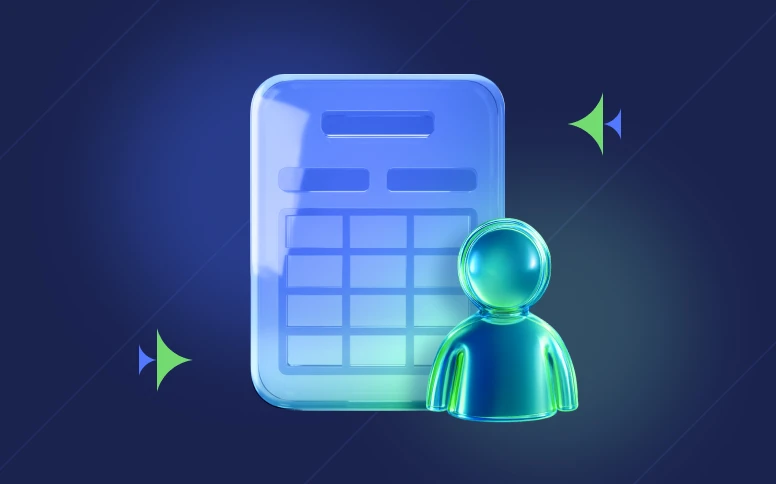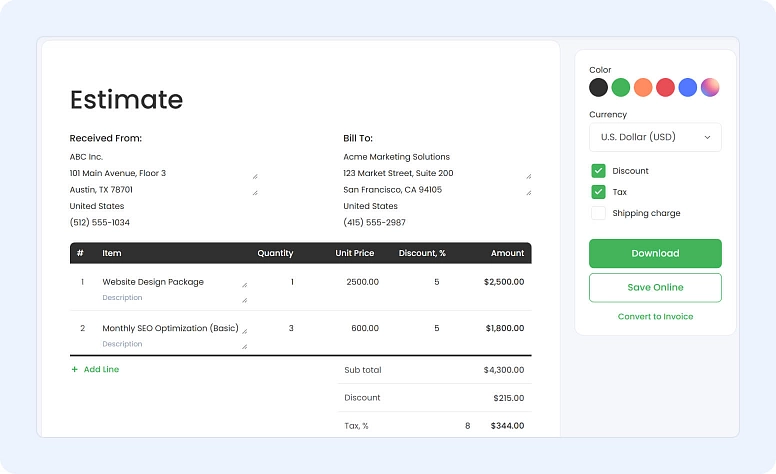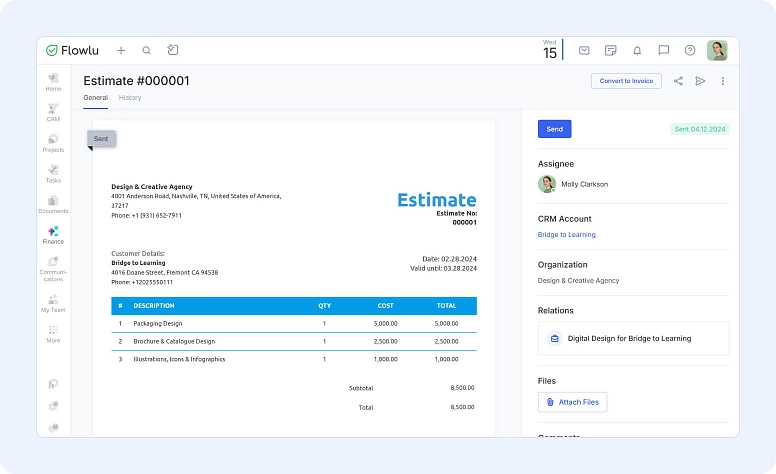How to Write an Estimate for a Job: A Complete Guide for Professionals
- What is an estimate?
- Estimate vs. quote vs. invoice vs. proposal
- Why estimates are important
- 10 essential elements every job estimate should include
- How to calculate an estimate
- Step-by-step: how to write a project estimate
- How Flowlu can help you create estimates
- Common mistakes when writing estimates
- Bottom line
When most people hear the word estimate, their first instinct is to look the other way. But here’s the thing: writing an estimate isn’t complicated. What matters most is knowing how to do it right.
Why? Because when you can confidently write up an estimate for a job, it becomes easier to win new clients, keep the ones you already have, and understand exactly how much profit you’ll make. This helps you decide whether to take the project or not.
In this guide, you’ll learn everything you need to know to write a professional estimate step by step.
Before we get into the details of how to create an estimate, it’s significant to understand what an estimate actually is and why it matters.
What is an estimate?
Simply put, an estimate needs to show both the total costs and the timeline accurately, but it doesn’t have any legal strength. And this is a very essential point, since many people use the terms estimate and quote as if they have the same meaning. In the case of a quote, it is just the same as an estimate, but it is a legal document. This makes all the difference.
Even if you are not legally punished when your estimate is not very accurate, it can still affect your reputation. That is why it is important to be careful when you are learning how to create a job costing.
For example, imagine you have a small landscaping business. A client asks you to build a new patio. In your cost estimate, you can include a short description of the project, a list of materials, labor costs, and the timeline. Even if this document is not a legal contract, it helps the client understand what to expect before signing.
You can also give different types of estimates depending on the stage of the project:
- Ballpark estimate: A quick, rough number often used in early discussions.
- Detailed estimate: A more precise document that includes itemized costs and timelines.
- Not-to-exceed estimate: Sets an upper limit on costs to protect both you and the client.
Choosing the right type can make communication clearer from the start.
Most estimates also include a validity period, which defines how long the pricing and terms are guaranteed. Typically, this is between 15 and 30 days. If the client doesn’t accept the cost estimate within this time, you can revise and resend it with updated pricing. This protects you from unexpected price changes or delays on the client’s side.
Estimate vs. quote vs. invoice vs. proposal
As we already mentioned above, many people use the terms estimate, quote, invoice, and proposal as if they mean the same thing, but they serve different purposes in a project.
- Estimate: A non-binding document that outlines the expected cost and timeline. It gives the client a general idea before work begins.
- Quote: A formal, legally binding offer with fixed pricing once accepted by the client.
- Invoice: A payment request issued after work is completed or milestones are met. It reflects the actual amount owed.
- Proposal: A more detailed document that not only includes pricing but also strategy, scope, and value. It’s often used for larger projects or competitive bids.
Understanding the difference between these documents helps to set the right expectations and avoid confusion later.
Why estimates are important
The truth is that even though you may provide a budget estimate, you will then need to deliver a quote. So, why do you need to learn how to estimate a job cost? Here are the most important reasons:
#1: Gain trust
No matter if you are working with a client for the first time or if he is a regular client, you want to make sure you build and keep his trust. When you give clear and accurate estimates, he knows what he can expect from you.
A recent survey found that 86% of consumers say transparency from businesses is more important than before. Giving clear and honest estimates helps build this trust from the beginning.
#2: Set clear expectations
When you give a cost calculation, you set a base for what your client expects to pay for your services. The numbers don’t have to match exactly, but they should be close enough, so the client doesn’t feel misled.
#3: Help you plan
Another great advantage of estimates is that they can be very handy to you as well. When you check the numbers of your cost estimate, you can determine if you should take the project or not. It might, in the end, not be economically viable for you at all. Besides, you’ll know exactly how much you’ll need to invest in resources and time in case the client accepts your offer.
Once you understand why creating estimates is important, the next step is to make sure they include the right details. Here are the main elements that every estimate should have.
Need to send a quick estimate to your client? We built a free tool to make it easy for you. No sign-up or usage limits. Just create and share your estimate in a few clicks >>Try the Free Estimate Generator
10 essential elements every job estimate should include
No matter if you’re using an estimate template or writing your estimate from scratch, it needs to include certain elements:
#1: Company info
You should include your company information, such as your address, email, phone number, social media contacts, and logo.
#2: Client information
You should also include the client’s name (or business name if needed), address, email, and phone number.
#3: Estimate number
While it seems obvious, it is important to keep track of the different estimates that you write for different jobs. So, you want to ensure that you give each one a number.
#4: Date
You should also include the date when you’re submitting the quote. Note that this isn’t the date when you expect to have the project completed.
#5: Project description
Your cost calculation always needs to include a brief description of the project. Make sure that you outline its scope and the timeline.
#6: The costs
You’ll need to add the different costs that you’ll have in this part of the estimate. You should add them line by line. Make sure that you don’t forget anything, including tools, supplies, materials, and even employee labor costs.
#7: Taxes
If there are taxes linked to the project, you should add them as well. While it’s not comfortable since they’ll increase the final price, keep in mind that you need to be completely honest to gain the trust of your clients. You’re detailing all costs upfront to ensure they know exactly what to expect.
#8: Total work estimate
As you can tell by its name, this is the total amount you estimate the client will need to pay for the project. You should make it prominent.
#9: Terms and conditions
This is the place where you set your terms regarding the payment, as well as protect yourself against any cost or price fluctuations.
#10: Thanks
At the end of the estimate, make sure to thank your client. Even if he does not accept your offer, it is important to stay polite and professional.
Knowing what to include is only the first step. To make the process simple and consistent, here is a clear step-by-step guide to writing a professional estimate.
How to calculate an estimate
Once you know what information your estimate should include, the next step is to calculate the actual numbers. A clear calculation helps you stay profitable and gives your client a realistic idea of what to expect.
Start by breaking your costs into three parts:
- Direct costs: These are the actual expenses directly related to the project, such as labor, materials, tools, and subcontractors.
- Indirect costs: These are overhead expenses like office costs, insurance, software, or utilities that support the work but are not tied to a single task.
- Profit margin: This is your markup. It makes sure the project is worth taking on financially.
A simple way to calculate is:
Direct costs + Indirect costs + Profit margin + Taxes = Total estimate amount.
For example, if a web design project has $1,500 in direct costs, $300 in indirect costs, and you add a 20% profit margin, your total estimate will clearly show your client what each part includes. This transparency also helps protect your profit.
Step-by-step: how to write a project estimate
Now that you already know why you need to use quote and what main elements to put inside, it is time to learn how to write an estimate for a job. It is not really difficult. With some practice, it will feel more natural very soon.
Steps on how to make a cost calculation:
Step #1: Gather all the details about the project
In the first step, you should take some time to understand what the client really needs and wants. You need to talk with the client and ask many questions so you can understand better what he is looking for.
Step #2: Determine the project scope
This is the step where you must decide everything that is connected to the project — the costs, the timeline, and also if you can do all the work alone or if you need to subcontract or outsource something.
It is important to remember that every project is different, especially in different industries. For example, if you are a personal trainer, the service depends on what your client needs. Maybe three hours per week in the gym is enough, or maybe it is better to make a bigger program with gym time and nutrition. If you are a construction contractor, maybe you will need to hire electricians or plumbers, depending on the work. Try to give as many details as you can.
Step #3: Estimate the time and cost of each task
You must also think about how much each task will cost and how long it will take. Even if you already know the total cost of the project, the client usually wants to see how much time and money each part will need. While we are writing “tasks,” these should be read as “stages” that can contain more than one task.
Make sure you include the prices for all subcontractors or outsourced people, and also all the materials that will be used. This can be things like tools, software, or even rent.
Besides the costs, you should also add a timeline for each stage, so the client knows when the work will be done. This allows the client to know where you should stand each step of the way. Also, by providing an accurate estimate, he will see that you’re organized and experienced.
For example, a construction contractor can show the costs step by step:
- Foundation: $5,000 (2 weeks)
- Framing: $8,000 (3 weeks)
- Plumbing and electrical: $6,500 (2 weeks)
- Finishing: $4,000 (1 week)
This simple timeline and cost structure help you and the client stay on the same page.
Step #4: Check out the competition
Before you show your cost calculation to the client, it is good to spend some time checking your competition and what they offer. This can help you make your estimate stronger and adjust it to your experience level.
Step #5: The terms and conditions
Even if you think everything is ready, there is still an important step: adding your terms and conditions to your estimate.
Here, you should write what can happen in different situations to avoid problems or confusion later. You also need to say clearly if you allow any changes or extra work, how many changes are allowed, and how they will be charged.
Something like “This document provides estimates, not exact costs for the services. Additional services not described in this document will be subject to a new estimate and fees.” should also be included.
Step #6: Send the estimate to the client
Now it’s finally time to email your pricing estimate to the client. Make sure that you add a note or letter explaining the estimate document that you’re sending.
You should make sure that in the email you introduce both yourself and your business. Just write a small summary of the cost calculation you’re sending as an attachment, and end the email with the benefits of working with you along with what the client needs to do to assign you the job.
After sending your estimate, don’t just wait. Follow up with the client after 2 or 3 business days to make sure they received the cost calculation and to answer any questions.
If the project is bigger, it is a good idea to present the estimate in a short call or video meeting. This gives you a chance to explain your process and build trust.
80% of sales require at least five follow-ups. A gentle and professional follow-up can make a big difference in winning the job.
How Flowlu can help you create estimates
The good news is that you don’t need to create estimates on your own. Flowlu is a simple and effective business management system that can help you manage your entire workflow, including creating quotes for your clients. All you need to do is add the information the platform asks for, and then everything is ready.
With Flowlu, you can easily change your estimates and save them as templates, so you don’t need to do the same work again and again. You can also change the background, text color, and size to make your estimates look professional and clear.
As soon as your estimate is ready, you can send it via email directly from Flowlu. And when the client approves it, Flowlu can help you once again by converting the estimate into an invoice with just a single click.
Common mistakes when writing estimates
Even people with a lot of experience can make small mistakes that create big problems later. Here are some common errors you should pay attention to:
- Not including indirect costs: Many people look only at materials and labor, but they forget the overhead costs. This can take away from your profit.
- Using descriptions that are not clear: If the project description is not clear, it can make misunderstandings and changes in the scope. It is better to be very clear about what is included.
- No validity period: When there is no expiration date, clients can come back after many months and still think the price is the same.
- Giving too short time: When you make the timeline too short to win the job, it often makes delays and unhappy clients.
- No clear terms and conditions: If there are no clear terms, it is more difficult to protect your business when something changes.
Avoiding these mistakes will make your estimates look more serious, more accurate, and easier for the client to accept.
Bottom line
As you can see, to learn how to write an estimate is not so complicated. The most important thing is to be precise and clear, so you and your client understand each other well.
Before you start writing the estimate, you should speak with the client about the project to get as many details as possible. This is the best way to know the real costs and the right timeline for the work.
Don’t forget that you can always use Flowlu to help you create your own estimates and automatically send them to clients. It won’t just be easier; it will also be faster, and you’ll make sure that you don’t forget any of the important elements that all estimates need to include, as discussed above.
In an estimate, it’s always better to be precise. So, you should add your costs as line items. This means that each line is specific to a material or service.
Even though there are many different estimation techniques (they even vary depending on your industry), the most popular one is the strategy that uses a breakdown structure. Simply put, you’ll separate the project into different components and add the price of each one. At the end of the estimate, you should provide the total cost of all these components.
There are numerous apps to create professional-looking estimates and quotations. We already mentioned Flowlu in this article, but you can also use Zoho, Wave, Refrens, and other online tools.


















